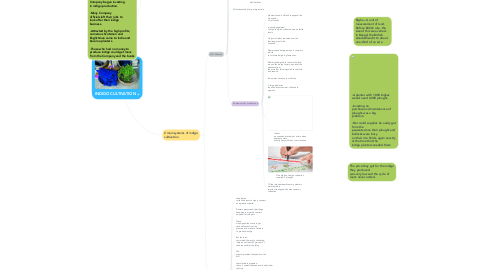
1. In the last decades of the eighteenth century: -Indigo cultivation in Bengal expanded rapidly -Bengal indigo came to dominate the world market. -In 1788 only about 30% of the indigo imported into Britain was from India. -By 1810, the proportion had gone up to 95% -As the indigo trade grew, commercial agents and officials of the Company began investing in indigo production. -Many Company officials left their jobs to look after their indigo business. -Attracted by the high profits, numerous Scotsmen and Englishmen came to India and became planters. -Those who had no money to produce indigo could get loans from the Company and the banks
2. Bigha – A unit of measurement of land. Before British rule, the size of this area varied. In Bengal the British standardised it to about one-third of an acre
3. 2 main systems of indigo cultivation
3.1. NIJ Cultivation
3.1.1. planter produced indigo in lands that he directly controlled
3.1.2. He either bought the land or rented it from other zamindars
3.1.3. produced indigo by directly employing hired labourers
3.1.4. required many ploughs
3.1.5. And bullocks
3.1.6. Cultivation took place in large scale
3.1.7. Problems with nij cultivavtion
3.1.7.1. planters found it difficult to expand the area under nij cultivation
3.1.7.2. -densely populated -Indigo could be cultivated only on fertile lands
3.1.7.3. Only small plots scattered over the landscape could be acquired
3.1.7.4. Planters needed large areas in compact blocks to cultivate indigo in plantations
3.1.7.5. Planters attempted to lease in the land around the indigo factory, and evict the peasants from the area. But this always led to conflicts and tension.
3.1.7.6. labour was not easy to mobilise
3.1.7.7. A large plantation required a vast number of hands to operate
3.1.7.8. labour was needed precisely at a time when peasants were usually busy with their rice cultivation.
3.1.7.9. One bigha of indigo cultivation required 2 ploughs
3.1.7.10. Till the late nineteenth century, planters were therefore reluctant to expand the area under nij cultivation
3.2. RYOTI Cultivavtion
3.2.1. the planters forced the ryots to sign a contract, an agreement (satta)
3.2.2. Planters pressurised the village headmen to sign the contract on behalf of the ryots
3.2.3. Those who signed the contract got cash advances from the planters at low rates of interest to produce indigo.
3.2.4. But the loan committed the ryot to cultivating indigo on at least 25 per cent of the area under his holding
3.2.5. The planter provided the seed and the drill
3.2.6. the cultivators prepared the soil, sowed the seed and looked after the crop
3.2.7. When the crop was delivered to the planter after the harvest, a new loan was given to the ryot
3.2.8. Peasants who were initially tempted by the loans soon realised how harsh the system was.
3.2.9. The planters usually insisted that indigo be cultivated on the best soils in which peasants preferred to cultivate rice
3.2.10. Indigo, moreover, had deep roots and it exhausted the soil rapidly. After an indigo harvest the land could not be sown with rice
